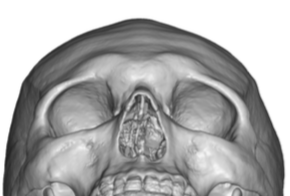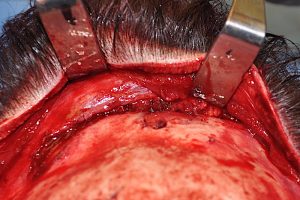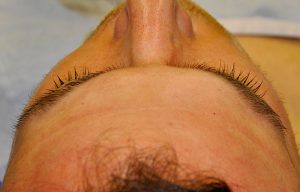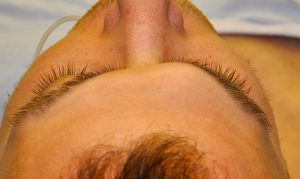Background: The brow bones are seen as the protrusions above the eyes that many assume are made up of solid bone. But that is only true for the outer calfs or tail of the brow bones. Half of the brow bones, the inner half on each side, is composed mainly of air because their shape represents the development of the underlying frontal sinuses. That has great relevance when it comes to their surgical reduction and is why the ‘setback bone flap’ technique is frequently used. The overlying bone cover is too thin to do a burring reduction method.

But despite being asymmetric in size the outer appearance of the brow bones is usually symmetric. This is because the asymmetry is usually in the width or height of the frontal sinus development not in its outward horizontal projection. But when an external brow bone asymmetry is seen the frontal sinus over development has affected its outward projection as well.
Having large symmetric brow bones is one type of aesthetic forehead issue. But having one bigger than the other is a more unique, but no less, aesthetically disturbing concern.
Case Study: This young male was bothered by his asymmetric brow prominence with the right side having a greater protrusion in its medial half. The four methods of incisional access were discussed and he opted for a trans coronal approach for correction.


There may be some cases of brow bone asymmetry in men and more frequently in women where a burring technique alone may be sufficient. But in men the most important issue is not how the brow bone protrusion is reduced but the access to do so. Like all aesthetic surgeries it almost always comes down to tradeoffs…is the scar needed to do the surgery a worthy tradeoff for the improvement in brow bone symmetry .Each patient must make that decision for themselves.
Case Highlights:
1) Significant asymmetries in the brow protrusions is a result of excessive pneumatization of one side.
2) Reduction of the unilaterally enlarged brow bone in a male requires a bone flap technique in most cases.
3) There are multiple transcutaneous methods to approve the brow bone from a direct, mid-forehead, hairline (pretrichal) and coronal scalp incisions, each with their own advantages and disadvantages.
Dr. Barry Eppley
Indianapolis, Indiana






